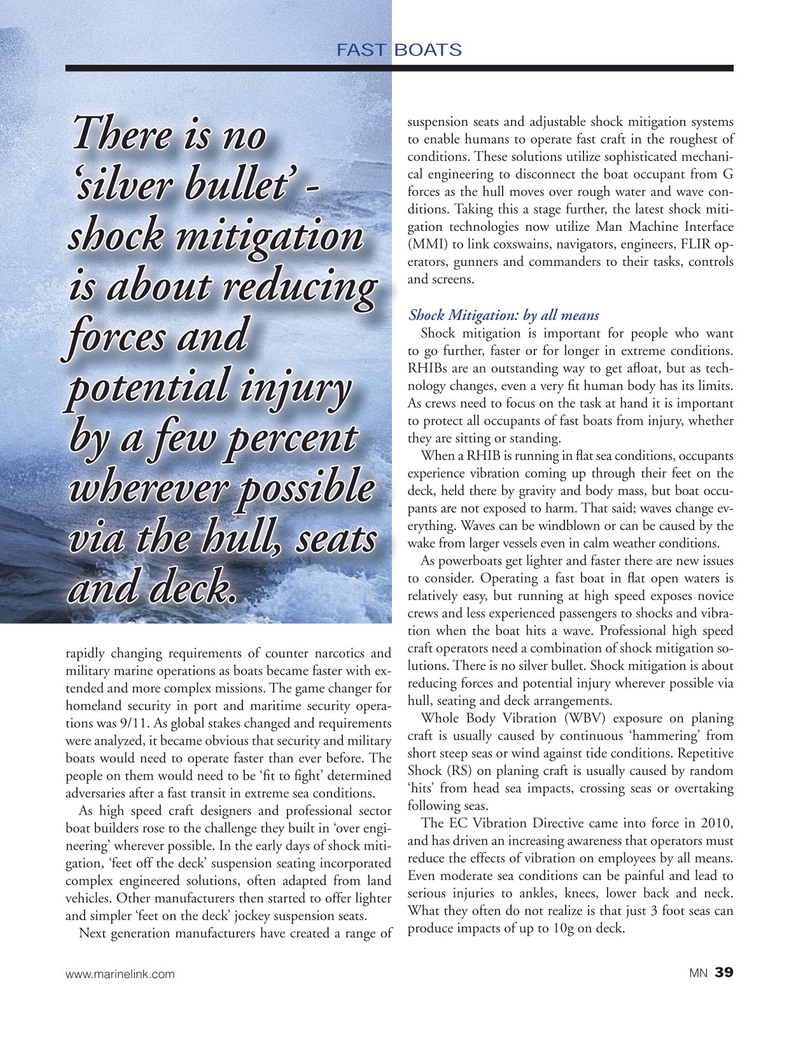
Page 39: of Marine News Magazine (October 2015)
Salvage & Spill Response
Read this page in Pdf, Flash or Html5 edition of October 2015 Marine News Magazine
FAST BOATS suspension seats and adjustable shock mitigation systems to enable humans to operate fast craft in the roughest of
There is no conditions. These solutions utilize sophisticated mechani- cal engineering to disconnect the boat occupant from G forces as the hull moves over rough water and wave con- ‘silver bullet’ - ditions. Taking this a stage further, the latest shock miti- gation technologies now utilize Man Machine Interface (MMI) to link coxswains, navigators, engineers, FLIR op- shock mitigation erators, gunners and commanders to their tasks, controls and screens. is about reducing
Shock Mitigation: by all means
Shock mitigation is important for people who want forces and to go further, faster or for longer in extreme conditions.
RHIBs are an outstanding way to get a? oat, but as tech- nology changes, even a very ? t human body has its limits. potential injury
As crews need to focus on the task at hand it is important to protect all occupants of fast boats from injury, whether they are sitting or standing.
by a few percent
When a RHIB is running in ? at sea conditions, occupants experience vibration coming up through their feet on the deck, held there by gravity and body mass, but boat occu- wherever possible pants are not exposed to harm. That said; waves change ev- erything. Waves can be windblown or can be caused by the wake from larger vessels even in calm weather conditions. via the hull, seats
As powerboats get lighter and faster there are new issues to consider. Operating a fast boat in ? at open waters is relatively easy, but running at high speed exposes novice and deck.
crews and less experienced passengers to shocks and vibra- tion when the boat hits a wave. Professional high speed rapidly changing requirements of counter narcotics and craft operators need a combination of shock mitigation so- lutions. There is no silver bullet. Shock mitigation is about military marine operations as boats became faster with ex- tended and more complex missions. The game changer for reducing forces and potential injury wherever possible via hull, seating and deck arrangements. homeland security in port and maritime security opera-
Whole Body Vibration (WBV) exposure on planing tions was 9/11. As global stakes changed and requirements were analyzed, it became obvious that security and military craft is usually caused by continuous ‘hammering’ from boats would need to operate faster than ever before. The short steep seas or wind against tide conditions. Repetitive people on them would need to be ‘? t to ? ght’ determined Shock (RS) on planing craft is usually caused by random ‘hits’ from head sea impacts, crossing seas or overtaking adversaries after a fast transit in extreme sea conditions.
As high speed craft designers and professional sector following seas.
The EC Vibration Directive came into force in 2010, boat builders rose to the challenge they built in ‘over engi- and has driven an increasing awareness that operators must neering’ wherever possible. In the early days of shock miti- gation, ‘feet off the deck’ suspension seating incorporated reduce the effects of vibration on employees by all means. complex engineered solutions, often adapted from land Even moderate sea conditions can be painful and lead to vehicles. Other manufacturers then started to offer lighter serious injuries to ankles, knees, lower back and neck.
What they often do not realize is that just 3 foot seas can and simpler ‘feet on the deck’ jockey suspension seats.
Next generation manufacturers have created a range of produce impacts of up to 10g on deck. 39 www.marinelink.com MN
MN Oct15 Layout 32-49.indd 39 9/21/2015 11:24:09 AM

 38
38

 40
40
